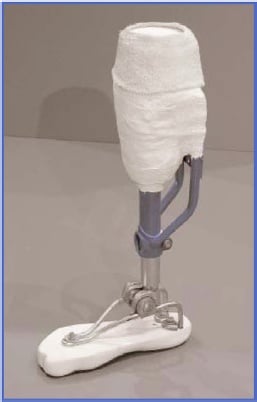
Problem being addressed[edit | edit source]
Eighty percent of the amputees in the world live in developing countries. Common causes of amputation are land mines, war, car accidents, natural disasters, industrial accidents, and lack of health issue awareness, which leads to diabetes, gangrene, and infection. The burden of limb loss for those in developing countries is big because they do not have money to buy and maintain prosthetic limbs. Loss of limb often results in the loss of livelihood.
The cost of a prosthetic limb in a developing country is found to range from $125 to $1875 USD. The cost of a prosthetic limb in the USA ranges from $5,000-$15,000 USD (Cheng 2004).
Detailed description of the solution[edit | edit source]
Adults require prosthesis replacement approximately every 1 to 2 years, while children usually require more frequent replacements of approximately every six months. This prosthetic for children was designed so that the prosthetic is adjustable (creating a longer useful life of the prosthetic), and it is made from local materials. The limb is constructed from local bicycle components, either new or used. The seat post and part of the frame are inverted and bolted to a foot shaped board. The fitting of the limb is accomplished by creating a cast of the limb and then attaching it to the bicycle component. The casting materials can be made from local materials, such as elephant grass, in some cases (Strait 2006). The total cost of the materials for the prosthetic is estimated to be around $20 USD. Purchasing a used bike frame and seat post would cost in the range of $5-$15. The wood for the foot would cost less than $1, and it could be lined with rubber from car or bicycle tires. If orthotic bandages were used, one to two rolls at $5 would be needed, but cheaper local resins or cellulose-rich plants could possibly replace this cost (ibid).
The main benefits of the limb are that it is adjustable, it requires little technical skill for manufacturing, its weight is comparable to the natural leg, and replacement parts (the wooden foot and the stump socket) are inexpensive. One limitation of this prosthetic is that there is no business plan outlined in order to move it into production.
Designed by[edit | edit source]
- Designed by: Vivian Cheng at Carleton University
- Manufacturing: This is a prototype and is not currently in production. One of the best features of this design, however, is that it can be produced locally almost anywhere in the world.
References[edit | edit source]
Internally generated reports[edit | edit source]
Cheng, Vivian. A Vistim Assitance Solution: Adapting Bicycle Technology for the Manufacture of Adjustable Prosthetic Legs for Children. 2004. CATIMAC. 12 April 2005. PDF available here.
Externally generated reports[edit | edit source]
Strait, E. (2006). Adjustable bicycle limb. In Prosthetics inDeveloping Countries, page 13. Link available here.